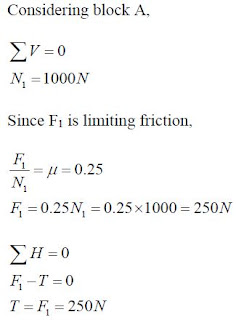FRICTION AND TYPES OF FRICTION
The force which opposes the movement or the tendency of movement is called Frictional force or simply friction. It is due to the resistance to motion offered by minutely projecting particles at the contact surfaces. However, there is a limit beyond which the magnitude of this force cannot increase.
- If the applied force is more than this limit, there will be a movement of one body over the other. This limiting value of frictional force when the motion is impending, it is known as Limiting Friction.
- When the applied force is less than the limiting friction, the body remains at rest and such frictional force is called Static Friction, which will be having any value between zero and the limiting friction.
- If the value of applied force exceeds the limiting friction, the body starts moving over the other body and the frictional resistance experienced by the body while moving is known as Dynamic Friction. Dynamic friction is less than limiting friction.
4. Dynamic friction is classified into following two types:
a) Sliding friction
b) Rolling friction
Sliding friction is the friction experienced by a body when it slides over the other body.
Rolling friction is the friction experienced by a body when it rolls over a surface.
5. It is experimentally found that the magnitude of limiting friction bears a constant ratio to the normal reaction between two surfaces and this ratio is called Coefficient of Friction.
Coefficient of friction = F/N
where F is limiting friction and N is a normal reaction between the contact surfaces. The coefficient of friction is denoted by μ.
μ = F/N
Laws of friction
- The force of friction always acts in a direction opposite to that in which body tends to move.
- Until the limiting value is reached, the magnitude of friction is exactly equal to the force which tends to move the body.
- The magnitude of the limiting friction bears a constant ratio to the normal reaction between the two surfaces of contact and this ratio is called coefficient of friction.
- The force of friction depends upon the roughness/smoothness of the surfaces.
- The force of friction is independent of the area of contact between the two surfaces.
- After the body starts moving, the dynamic friction comes into play, the magnitude of which is less than that of limiting friction and it bears a constant ratio to normal force. This ratio is called coefficient of dynamic friction.
Angle of friction
Consider the block shown in figure resting on a horizontal surface and subjected to horizontal pull P. Let F be the frictional force developed and N the normal reaction. Thus, at contact surface the reactions are F and N. They can be graphically combined to get the reaction R which acts at angle θ to the normal reaction. This angle θ called the angle of friction is given by
tanϴ = F/NAs P increases, F increases and hence θ also increases. θ can reach the maximum value α when F reaches limiting value. At this stage,
tanα = F/N = μ
This value of α is called Angle of Limiting Friction. Hence, the angle of limiting friction may be defined as the angle between the resultant reaction and the normal to the plane on which the motion of the body is impending.
Angle of repose
Consider the block of weight W resting on an inclined plane which makes an angle θ with the horizontal. When θ is small, the block will rest on the plane. If θ is gradually increased, a stage is reached at which the block start sliding down the plane. The angle θ for which the motion is impending, is called the angle of repose. Thus, the maximum inclination of the plane on which a body, free from external forces, can repose is called Angle of Repose.
Resolving vertically,
N = W. cos θ
Resolving horizontally,
F = W. sin θ
Thus, tanϴ = F/N
If ɸ is the value of θ when the motion is impending, the frictional force will be limiting friction and hence,
tan ɸ = F/N
= μ = tan α
ɸ = α
Thus, the value of the angle of repose is same as the value of limiting angle of repose.
Cone of friction
- When a body is having impending motion in the direction of force P, the frictional force will be limiting friction and the resultant reaction R will make limiting angle α with the normal.
- If the body is having impending motion in some other direction, the resultant reaction makes limiting frictional angle α with the normal to that direction. Thus, when the direction of force P is gradually changed through 360°, the resultant R generates a right circular cone with a semi-central angle equal to α.
Problem 1: Block A weighing 1000N rests over block B which weighs 2000N as shown in the figure. Block A is tied to the wall with a horizontal string. If the coefficient of friction between blocks A and B is 0.25 and between B and floor is 1/3, what should be the value of P to move the block (B), if
(a) P is horizontal.
(b) P acts at 30° upwards to horizontal.
Considering block A,
Problem 2: A block weighing 500N just starts moving down a rough inclined plane when supported by a force of 200N acting parallel to the plane in an upward direction. The same block is on the verge of moving up the plane when pulled by a force of 300N acting parallel to the plane. Find the inclination of the plane and coefficient of friction between the inclined plane and the block.
Sol.











0 Comments